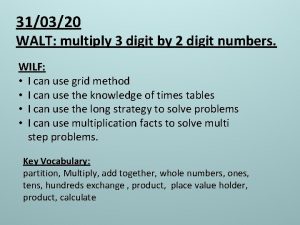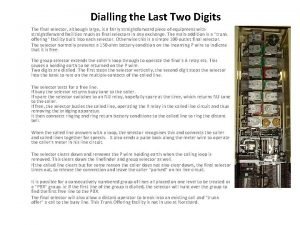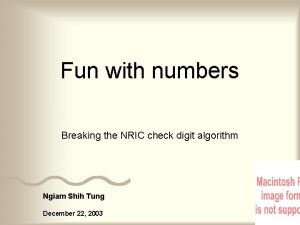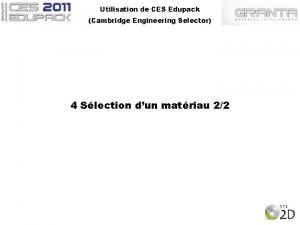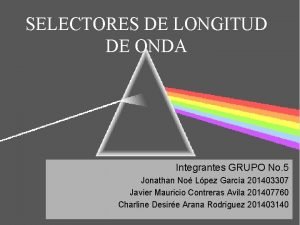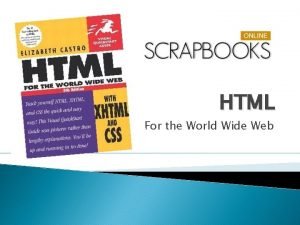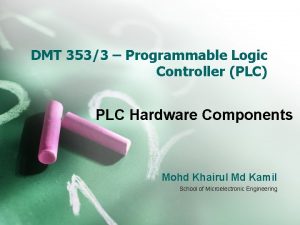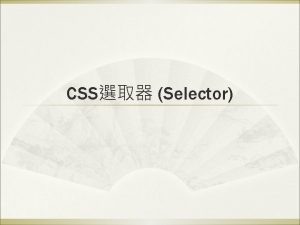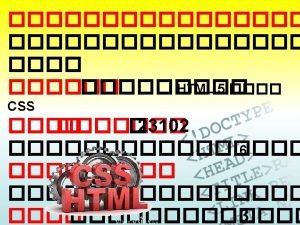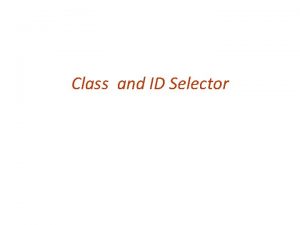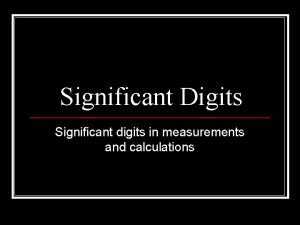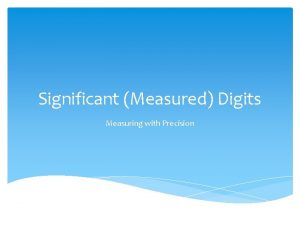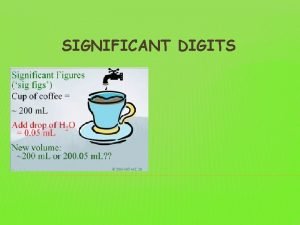Dialling the Last Two Digits The final selector










- Slides: 10

Dialling the Last Two Digits The final selector, although large, is a fairly straightforward piece of equipment with straightforward facilities much as final selectors in any exchange. The main addition is a "trunk offering" facility built into each selector. Otherwise this is a simple 100 outlet final selector. The selector normally presents a 150 ohm battery condition on the incoming P wire to indicate that it is free. The group selector extends the caller's loop through to operate the final's A relay etc. This causes a holding earth to be returned on the P wire. Two digits are dialled. The first steps the selector vertically, the second digit steps the selector into the bank to rest on the multiple contacts of the called line. The selector tests for a free line. If busy the selector returns busy tone to the caller. If spare the selector switches to an NU relay, hopefully spare at the time, which returns NU tone to the caller. If free, the selector busies the called line, operating the K relay in the called line circuit and thus removing the bridging apparatus. It then connects ringing and ring return battery conditions to the called line to ring the distant bell. When the called line answers with a loop, the selector recognises this and connects the caller and called lines together for speech. It also sends a pulse back along the meter wire to operate the caller's meter in his line circuit. The selector clears down and removes the P wire holding earth when the calling loop is removed. This clears down the linefinder and group selector as well. If the called line clears but for some reason the caller does not also clear down, the final selector times out, to release the connection and leave the caller "parked" on his line circuit. It is possible for a consecutively numbered group of lines all placed on one level to be treated as a "PBX" group. ie If the first line of the group is dialled, the selector will hunt over the group to find the first free line to the PBX. The final selector will also allow a distant operator to break into an existing call and "trunk offer" a call to the busy line. This Trunk Offering facility is not in use at Norchard.

Dialling the Last Two Digits This diagram has been taken from Atkinson as it is simple to look at. However there are some changes when a current diagram is inspected. In particular, int batt and eth is no longer used. The selector normally presents a 150 ohm battery on the incoming P wire to indicate that it is available. The previous selector extends the caller's loop through to the final selector on the incoming and + wires. This operates relay A. A 1 operates relay B. B 6 removes the P wire battery and replaces it with an earth. B 4 operates relay C (CD in the modern design). When the caller dials the penultimate digit A 1 repeats the pulses to the vertical magnet. On the first pulse the selector steps up to level 1 and operates its N springs. N 2 short circuits the 700 ohm winding of the C (CD) relay which becomes slow to release. The magnet current pulses in the 5 ohm winding maintain C (CD) during pulsing. Also, when A 1 releases during the pulsing it short circuits the B relay, which becomes slow to release. Relay B also holds during pulsing. At the end of the dial pulse train, relay A remains operated, but the magnet current ceases and C (CD) releases. C 3 operates relay E from the vertical magnet battery to the N 2 earth. E 6 removes the short circuit from the C (CD) relay so that it can re-operate. Relay E holds to the vertical magnet battery via contacts C 3 and E 1.

The caller now dials the final digit and the A 1 contact sends current pulses to the rotary magnet via E 4, the 5 ohm C (CD) winding, C 1 A 1 and the B 1 earth. The selector steps around the level to the required number. On the first step, the NR springs are operated by the selector. NR 2 again short circuits the 700 ohm winding of relay C (CD) making the relay slow to release. Relay C (CD) holds due to the magnet current flowing through the 5 ohm winding. When the last digit has been completed the final selector is standing on the required line and the magnet current ceases allowing relay C (CD) to release.

The selector now has to test the dialled line to see if it is free or busy. A free condition is denoted by a 1300 ohm K (or NU) relay battery on the P wire. The line will be busy if the P wire is "dis" or earthed. When C (CD) releases, C 3 disconnects relay E which releases slowly. E 6 takes the short circuit off the C (CD) relay to allow it to re-operate again. Thus C (CD) releases for the short period of the release lag of relay E. During this period, C 2 connects the H relay to the called P wire to see if there is a battery present. If the line is busy, C 2 cannot operate relay H (and HR), but when E releases E 2 can operate relay G to the NR 2, N 2, B 1 earth. G 6 connects busy tone to the A relay 570 winding, which uses the relay as a transformer to send the tone to the caller. Should the caller dial any further digits, they are ineffective as C 1 has disconnected the magnet circuits.

If the line is free, C 2 operates relay H to the 1300 ohm battery on the P wire. H 2 operates relay HR. H 4 earths the P wire to busy the called line and to operate the K relay in the line circuit and so remove the bridging apparatus. H 6 holds relay H. When E 2 releases, relay J is operated. J 1 connects intermittent ring earth to the + wire to the called line, whilst HR 2 connects ring return battery to the - wire. J 2 connects ring tone to the A relay and caller's telephone. The AC from the ringer passes through the called line's capacitor and bell in the telephone to ring the bell. DC cannot flow yet and so relay F, being very slow to operate will not be affected by the AC component. When the called line answers, the telephone loop allows DC to flow from the ring return battery to the ringer earth. This operates relay F. F 2 removes the short circuit from the 400 ohm winding to hold the relay. F 5 and F 6 extend the called line's loop to operate relay D and to connect the caller and called lines together via the transmission bridge of the selector. So long as the called line presents an ordinary loop, relay D will operate. D 1 re-operates relay E. E 2 releases relay J slowly. Whilst E is operated and J is still releasing, E 5 and J 4 return a 150 ohm battery pulse on the M wire to operate the meter in the caller's line circuit. J 2 removes the ring tone from the A relay.

The two lines are now connected together and are being fed line current via the A and D relays. At this stage the following relays are operated during the call. Relays A, B, E, F, H, HR. B 6 is holding an earth onto the incoming P wire to hold the connection from the linefinder and group selector. H 4 is holding an earth on the outgoing P wire to hold the K relay in the called line circuit and to keep that line busy.

Clear Down Should the caller clear first, relay A releases when the loop disappears. Relay B releases. B 6 removes the holding earth from the P wire, allowing the linefinder and group selector to restore also. B 1 releases relays H, HR, E and F. H 1 and H 3 release relay D. H 5 completes a self drive circuit for the rotary magnet which restores the selector to its normal position. When the selector is normal, the N springs restore and N 2 reapplies the 150 battery to the incoming P wire to indicate that the final selector is free again. Should the called line clear first, relay D releases. If the caller now clears the restoration of the selector is as above. If the caller does not clear, then the selector times out. D 2 connects the TM relay to the TP start wire. TM operates when the next start pulse arrives and holds to the TP hold wire. Eventually TM 3 allows relay G to operate to the TP release wire. G 4 removes the A relay earth to release the A relay. Relay A releases relay B etc and the selector restores to normal. The loss of P wire earth at the caller's line circuit causes the caller to be parked on to the line circuit P relay. Mean while the final selector is available for further calls.

PBX Group Working If a PBX group of lines is allocated to a level of the final selector multiple, the first line of the group is marked by connecting a battery condition to the P 2 wire on the multiple. Intermediate lines are not marked on the multiple and last lines are marked with an earth. These markings are made with straps on the multiple connections on the rear of the rack. If the first line of the group is free, it is seized as above. Relay HS may operate momentarily to the marking P 2 battery but it will not hold once relay C re-operates. If the first line is busy, then relay H does not operate but HS will when C 5 releases. HS 2 holds Relay HS. Relay E releases and relay C (CD) re-operates as before. C 4 and HS 1 energise the rotary magnet which steps the selector to line 2 of the group. As the selector finishes its rotary stroke the interrupters operate and R 1 operates the G relay. G 3 disconnects the magnet which releases. R 1 restores to normal releasing relay G G 3 reconnects the magnet which steps the selector to line 3. This process continues while it is stepping (quite slowly) over the PBX lines in sequence.

When the wipers step onto a free line, the P wire battery operates relay H in series with the G relay. H 2 operates relay HR as before. H 5 disconnects the rotary magnet path. HR 6 releases relay G (HR 3 short circuits the other winding). C 5 and H 6 disconnect relay HS which releases. HS 4 now operates relay J and the call proceeds as for an ordinary line. If the last line of the group is also busy then the selector encounters an earth on the P 2 wiper. This earth will hold relay G via the 2000 ohm resistor and prevent any further stepping. Relay H will not have operated so that contact G 5 can release relay HS. G 6 and HS 5 connect busy tone to the A relay for transmission to the caller.

The trunk offering facility is not described as it is unlikely that it will be in use at this time.
 How to multiply 3-digit numbers by 2-digit numbers
How to multiply 3-digit numbers by 2-digit numbers The final selector is connected to the
The final selector is connected to the Singapore nric checksum formula
Singapore nric checksum formula Cambridge engineering selector
Cambridge engineering selector Ces edupack
Ces edupack Echele
Echele Meal selector
Meal selector Identify a contextual selector that matches any element
Identify a contextual selector that matches any element Taguchi array selector
Taguchi array selector Selector switch symbol plc
Selector switch symbol plc Css selector attribute
Css selector attribute
